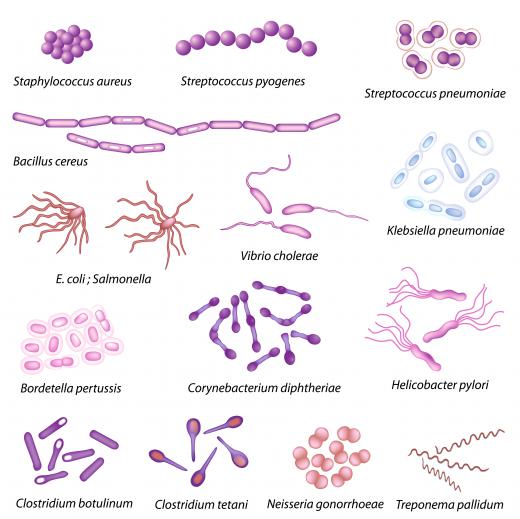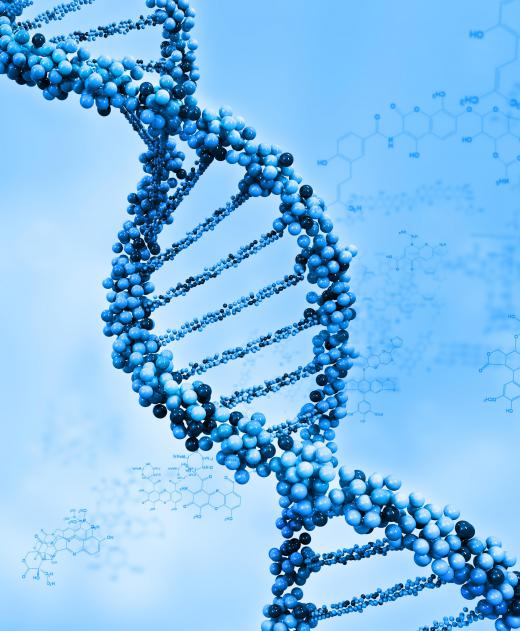What are Some Structural Characteristics of Bacteria?
 Michael Anissimov
Michael Anissimov
Bacteria are the world's most common organisms, with an estimated five nonillion (5 x 1030) bacteria on Earth. "Bacterium" means "small staff" in Greek. They come in a variety of shapes and sizes -- rods, spheres, spirals, helical, blogs, etc. The largest bacteria is half a millimeter long (though this is very atypical), and the smallest is just 0.3 microns across. Typical size is between 0.5 and 5.0 microns. The characteristics of bacteria are among the most varied in any domain of life -- the relatedness between two species of bacteria is often much less than the relation between any two given metazoans, say a human and a slug.
Though they infect everything and can kill off billions of other organisms, bacteria have a relatively simple structure. Though they were once thought of as simple cytoplasm bags, bacteria do actually have complexity, just not nearly as much as found in eukaryotic (large, complex, nucleated) cells. The basic structure is a capsule protected by a lipid membrane. Within the capsule is the bacterial "blood", cytoplasm; plasmids, semi-independent internal loops of DNA that can confer special abilities to bacteria in times of crisis; ribosomes, which manifest the "will" of the bacterial DNA by constructing protein complexes; and an irregularly shaped body containing the bacterial DNA, called the nucleoid. These structural characteristics of bacteria have been retained for billions of years.

Though relatively simple, what complexity there is to be had in the bacterial structure is fascinating, and accounts for the diverse characteristics of bacteria we see displayed in Nature. One of the key elements that accounts for the characteristics of bacteria are their internal plasmids. These short loops of DNA are exchanged like trading cards between bacteria, and like Magic cards, give them unique abilities. For instance, one plasmid may code for a protein that poisons all organisms in the area except for the bacteria and its immediate relatives. This can come in pretty handy for a bacteria trying to carve its own niche out of limited space and resources.

Other characteristics of bacteria come from the bacteria DNA, which is somewhat less modifiable than the plasmids. These include ultrastructural features such as the presence and number of pili (the organ used by bacteria to engage in conjugation with others of the same species), the number and size of flagella (important for movement in some species), the nature of the prokaryotic cytoskeleton (which determines the overall structure), and others. As bacteria are so small and diverse, we still have a lot to learn about how they work, and modern molecular genetics and advanced microscopy is showing the way.
AS FEATURED ON:
AS FEATURED ON:













Discussion Comments
OK, so now after reading this I think I understand the general characteristics of bacteria, but what does it mean when someone talks about the cultural characteristics of bacteria?
For instance, the other day I read an article talking about the cultural characteristics of e. coli bacteria -- what does that mean?
And what is the difference between the cultural characteristics of a bacteria and the general characteristics of a bacteria?
This article was so helpful for my daughter's biology homework. She's just starting in on the "biochemical characteristics of bacteria", which me being a music teacher, I have absolutely no idea about. In fact, I'm not overly confident that I actually know what a biochemical characteristic is.
Anyway, when she came home asking me about the 3 main characteristics of bacteria, I was absolutely at a loss -- thanks so much for the clear, concise information.
What an in-depth article -- thanks for going through all of the major characteristics of bacteria. I just have one more question -- what does it mean when a bacteria is gram negative or gram positive?
For instance, how would the general characteristics of a gram negative bacteria differ from those of a gram positive bacteria?
And also, how does such a bacteria test determine the type of bacteria present? Perhaps I'm just not getting it yet.
Can anybody clear this up for me?
Thanks!
Post your comments